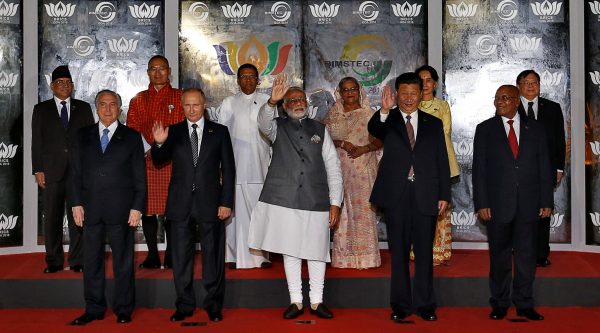While there are countless observations and policy reviews about the centrality of the Bay of Bengal and BIMSTEC, the sub-region has received little policy attention. This is paradoxical considering that the sub-region should have been central to the Indian sub-continent’s political and economic strategy.
Thanks to political instability and turmoil in surrounding Bangladesh, Thailand, Myanmar and Sri Lanka, as well as reluctance on the part of some members, BIMSTEC has struggled to catch up to comparable groupings in its neighbourhood, like the China-led Greater Mekong Sub-region initiative. BIMSTEC’s teething troubles were such that it only formed a secretariat in Dhaka, Bangladesh in September 2014, 17 years after its establishment.
But of late, the Bay of Bengal, and particularly BIMSTEC, have gained prominence in the foreign policymaking of countries in the sub-region. This is evidenced by India’s recently announced US$120 billion Sagarmala project, the India-led Bangladesh, Bhutan, India and Nepal (BBIN) Motor Vehicles Agreement, the Trilateral Maritime Security Cooperation Initiative between India, Sri Lanka and the Maldives, and finalisation of the India–Bangladesh land boundary agreement.
Notably, at the group’s 8th ministerial meeting in Kathmandu on 11 August 2017, all seven countries agreed to expedite the BIMSTEC free trade agreement, which has been on the agenda since 2004. This is important considering that South Asia is yet to witness the realisation of a free trade area.
The rising salience of BIMSTEC in India’s political and economic calculus was also evident at the 2016 BRICS (Brazil, Russia, India, China, South Africa) Outreach Summit in India, where BIMSTEC leaders joined for a BRICS–BIMSTEC meeting. The BIMSTEC grouping was chosen over SAARC (South Asian Association for Regional Cooperation), which many considered the natural choice for such a meeting.
The Bay of Bengal is one of the most underutilised sub-regions in terms of developing maritime trade linkages, collective utilisation and protection of natural resources, and enhancement of physical and digital connectivity.
In the absence of a comprehensive and long-term approach for the Bay of Bengal sub-region, countries have been making use of the limited opportunities in their own way. For instance, Myanmar has sought China’s help in the Kyaukphyu Special Economic Zone and Japan’s assistance in the Thilawa Special Economic Zone. Myanmar has also brought Thailand on board for the Dawei Port Project and India has played a large role in the development of Myanmar’s Sittwe port. Bangladesh will also seek Chinese assistance in its port and industrial development activities.
Similarly, Sri Lanka has looked for Chinese investment in its Hambantota port development. But given its overdependence on China, Sri Lanka is planning to diversify its contracts for the construction of Hambantota airport to India, which will be alongside India’s existing development of the Trincomalee port.
The Bay of Bengal is an important example of India’s commitment to establish itself as a benign power. India has been instrumental in providing funds to set up the BIMSTEC Secretariat in Dhaka, in keeping the group united and in pursuing new members such as Bhutan and Nepal. Unlike the South China Sea, the Bay of Bengal is a peaceful area in terms of state-to-state relations, with India as the predominant power striving to amicably resolve its differences with its neighbours.
To step up sub-regional cooperation, New Delhi should work on improving digital, economic and people-to-people connectivity. This is important if it intends to secure its interests in these waters. The Bay of Bengal area should be developed as the hub of a sub-regional supply chain mechanism, involving land-locked countries such as Bhutan, Nepal and India’s north-eastern states, and the littoral sub-region of Bangladesh, Myanmar, Thailand, Sri Lanka and coastal India. Developing India–Myanmar port connectivity and access to India’s north-eastern states through Bangladesh and Myanmar are critically important in that regard.
The Trilateral Maritime Security Cooperation is a remarkable example of BIMSTEC countries recognising the importance of their maritime strategies, after India’s Ministry of External Affairs announced in March 2014 that ‘the three countries agreed on a roadmap for cooperation in maritime security’. But further maritime coordination, joint development of ports and multilateral cooperation to harness the full potential of the Bay of Bengal sub-region needs to be prioritised by all Bay of Bengal countries. How fast and to what extent they are able to push the sub-regional agenda of BIMSTEC forward remains to be seen.
Rahul Mishra is a Delhi-based analyst on East Asian affairs. Sana Hashmi is a Sinologist and author of the book China’s Approach towards Territorial Disputes.

